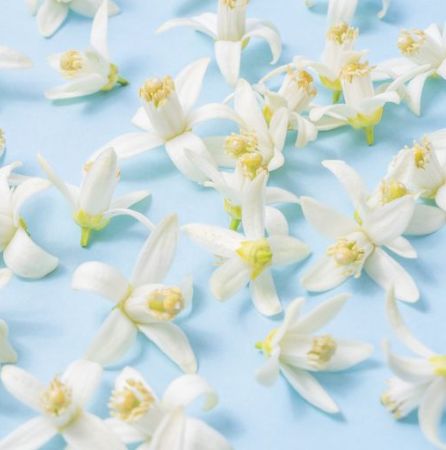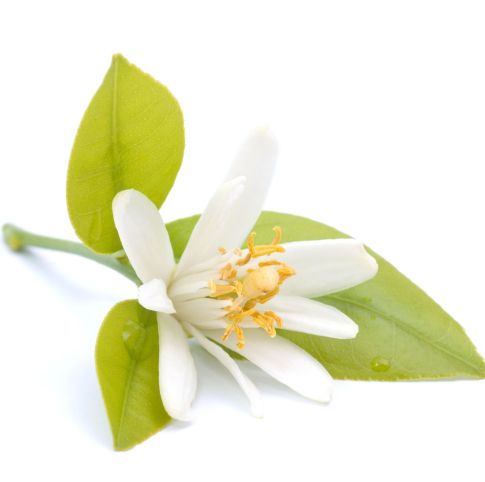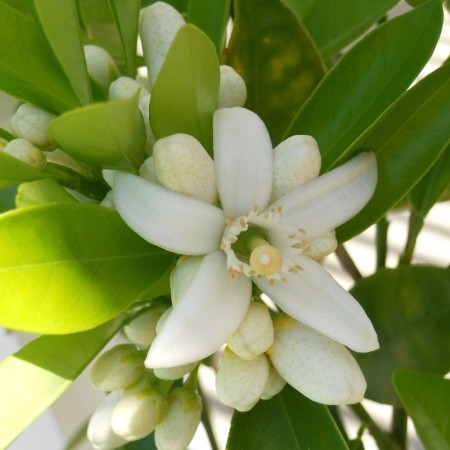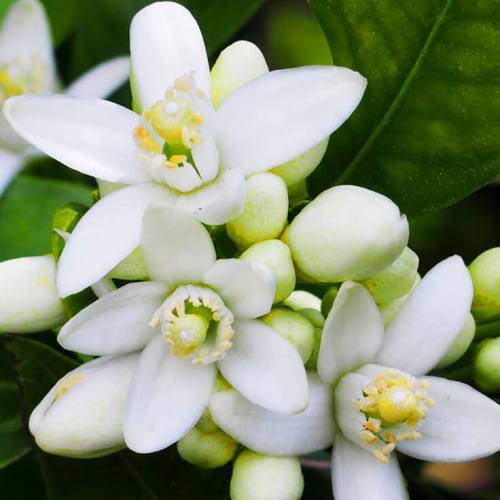-Essential-Oil.png)
-Essential-Oil.png)




Botanical name Citrus aurantium
Family Rutaceae
Source Flowers
Origin Egypt
Processing Method Steam Distilled
Color/Consistency A thin, clear, pale yellow liquid.
Aromatic Summary / Note / Strength of Aroma A middle note with a medium aroma, this type has dry top notes.
Blend with Benzoin, Geranium, Lavender, Jasmine, Ylang-Ylang, Rosemary, and Sandal Wood.
Product Abstract
Its scent isn’t the only reason you’ll want to read on. This Essential oil is excellent at soothing agitated nerves and is especially effective at relieving feelings of grief and despair. Plus, you can actually reduce your blood pressure and cortisol levels just by smelling this wondrous oil. Give up? I’m talking about neroli essential oil, which comes straight from the flowers of an orange tree!
History
By the end of the 17th century, Anne Marie Orsini, duchess of Bracciano and princess of Nerola, Italy, introduced the essence of bitter orange tree as a fashionable fragrance by using it to perfume her gloves and her bath. Since then, the term "neroli" has been used to describe this essence. Neroli has a refreshing and distinctive, spicy aroma with sweet and flowery notes.
Harvesting/Extraction Information
Neroli oil is yet another essential oil from a citrus fruit. Because of that fact, most of its medicinal properties match those of other citrus essential oils. This oil is extracted by steam distillation of flowers of Neroli which has the botanical name Citrus Aurantium. There is another name, Citrus Vulgaris, which is often assigned to it as well. The chief components of this essential oil are Alpha Pinene, Alpha-Terpinene, Beta-Pinene, Camphene, Farnesol, Geraniol, Indole Nerol, Linalool, Linalyl Acetate, Methyl Anthranilate, Nerolidol, and Neryl Acetate.
Common Usage
Caution
There are no inherent threats of using neroli essential oil. You should avoid using it when you need to concentrate on something or if you want to avoid sleep, due to its strong sedative nature.
Key constituents
Linalool 43.7–54.3%
(þ)-Limonene 6.0–10.2%
Linalyl acetate 3.5–8.6%
(E)-b-Ocimene 4.6–5.8%
a-Terpineol 3.9–5.8%
b-Pinene 3.5–5.3%
Geranyl acetate 3.4–4.1%
(E)-Nerolidol 1.3–4.0%
Geraniol 2.8–3.6%
(E,E)-Farnesol 1.6–3.2%
Neryl acetate 1.7–2.1%
b-Myrcene 1.4–2.1%
Sabinene 0.4–1.6%
Nerol 1.1–1.3%
(Z)-b-Ocimene 0.7–1.0%
Quality Neroli oils are expensive and are subject to frequent adulteration. Reconstituted oils may be added, or passed off as neroli oil. Considerable quantities of leaf and twig material may be distilled along with the blossoms.
Safety summary
Hazards None known.
Contraindications None known.
Regulatory guidelines
Has GRAS status. According to IFRA, essential oils rich in linalool should only be used when the level of peroxides is kept to the lowest practical value. The addition of antioxidants such as 0.1% BHT or a-tocopherol at the time of production is recommended.
Organ-specific effects
Adverse skin reactions Undiluted neroli oil was not irritating to rabbit, pig or mouse skin; tested at 4% on 25 volunteers it was neither irritating nor sensitizing. It is non-phototoxic. In a multicenter study, Germany’s IVDK reported that 49 of 6,220 dermatitis patients suspected of fragrance allergy (0.79%) tested positive to 2% neroli oil. Only nine patients had þþ or þþþ reactions. Two cases of alleged ACD to neroli oil have been reported, but in neither case was clinical relevance established, and patch testing only elicitedþreactions. Oxidation products of linalool may be skin sensitizing.
Reproductive toxicity The low reproductive toxicity of linalool, (þ)-limonene and b-pinene. Suggests that neroli oil is not hazardous in pregnancy.
Systemic effects
Acute toxicity Neroli oil acute oral LD50 in rats 4.55 g/kg; acute dermal LD50 in rabbits >5 g/kg.
Carcinogenic/anticarcinogenic potential No information was found for neroli oil, but it contains no known carcinogens. (þ)-Limonene, nerolidol and geraniol display anticarcinogenic activity.
Comments
Boelens & Boelens also analyzed a Tunisian neroli oil, and found no significant differences between this and the ranges given above for Spanish neroli. See Orange flower for the equivalent absolute of this flower oil.